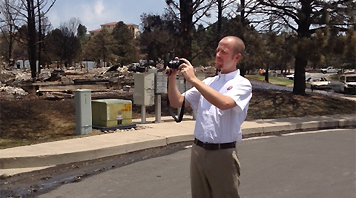|
RMIIA News Releases7951 E. Maplewood Avenue, Suite 110 Contact: Carole Walker, Executive Director Tinderbox Conditions Spark Concern for Colorado Homeowners – With No Relief in Sight, Residents in High Risk Areas Need to Take Action Against Wildfire Threat. November 15, 1999 – Extremely dry and unusual late season conditions are all the ingredients needed to ignite an urban wildfire. The two fires that broke out Sunday in Keystone and Aurora point to the dangerously dry weather and why residents who live in high risk areas may easily find themselves in the path of a wildfire. While Mother Nature isn't providing any relief that doesn't mean residents can't take necessary steps to help protect themselves and their homes against the threat of wildfire. WHY ARE WE AT RISK? Each year, the Rocky Mountain Region's risk for urban wildfires increases because our growing population is building new communities that once were wild land areas surrounding established cities and towns. Where we choose to live, combined with our rapid growth, is straining the resources of our fire departments, which no longer can get a fire engine to every home at risk. "That means fire protection has to be everybody's responsibility," said Rocky Mountain Insurance Information Association Executive Director, Carole Walker. "If we each take steps now to protect our own homes – both inside and outside – we can give the fire department a chance to save more homes if an urban wildfire threatens our community." HOW CAN I HELP THE FIRE DEPARTMENT SAVE MY HOME? Make it easy for firefighters to get to your home. Roads need to be wide enough to accommodate fire trucks, and there has to be a place for them to turn around. Driveways and bridges must be strong enough to carry heavy emergency vehicles. Identify at least two ways to and from your house and make sure they're well marked. All access routes to your home should be free of low hanging tree branches and cleared of flammable vegetation at least 10 feet from roads and five feet from driveways. In addition, it's important to maintain an emergency water supply that meets fire department standards, such as a community water hydrant system, a cooperative emergency storage tank with neighbors, or a minimum storage supply of 2,500 gallons on your property. If your water comes from a well, consider an emergency generator to operate the pump during a power failure. Clearly mark all water sources, and create easy access to your closest emergency water source. HOW CAN I SLOW DOWN A WILDFIRE HEADED TOWARD MY HOUSE? Long before there's a wildfire, create a 30-foot defensible space around your home by removing as much flammable material as you can. Replace flammable vegetation with fire resistive plants. Reduce the number of trees in heavily wooded areas by spacing native trees and shrubs at least 10 feet apart. On trees taller than 18 feet, prune lower branches within six feet of the ground. Remove branches overhanging the roof or coming within 10 feet of the chimney. Clean all dead leaves and needles from the roof, gutters, and yard. While the landscaping is important, don't forget about manmade fire hazards. Install a roof that meets a fire classification of "Class C" or better. Cover the chimney outlet and stovepipe with nonflammable screening no larger than half-inch mesh. Install dual- or triple-paned windows, and limit the size and number of windows that face large areas of vegetation. Put woodpiles and liquid propane gas tanks at least 30 feet from all structures and clear away flammable vegetation within 10 feet of those woodpiles and propane tanks. WHAT DO I DO IF A WILDFIRE TARGETS MY HOUSE? If you have time before you evacuate your family and pets (Your family has an evacuation plan in place, right?), back your car into the garage, leave the key in the ignition, and close the garage door. Close windows and doors to the house, and close all inside doors. Take down drapes and curtains. Place a ladder against the front of the house. If you have a combustible roof, wet it down or turn on roof sprinklers. Turn off the gas at the meter and the butane tank. Place fire fighting tools, such as 100 feet of pre-connected garden hose, a shovel, a rake, a bucket, and containers filled with water, in an accessible place. If you cannot evacuate, the safest place for protection is inside the house. "We definitely have the power to protect our homes and families from an urban wildfire, as long as we use foresight and common sense," Walker said. ### Rocky Mountain Insurance Information Association is a non-profit consumer information organization. Affiliated with the Insurance Information Institute, RMIIA has been serving consumers and the media since 1952. |
|
303-790-0216 • 800-355-9524 • Contact Us • Legal Notice, Disclaimer & Terms of Use
Home • About RMIIA • News Room • P&C Insurance Industry • Auto • Homeowners • Business • Catastrophes • Agent Resources • Events & Education • Brochures

